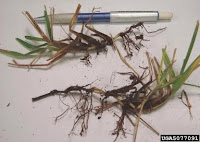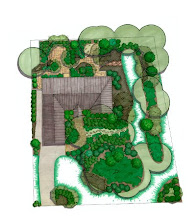Summer time brings juicy red tomatoes, plump yellow squash, and other beautiful vegetables in your garden. But why not landscape with edible plants and have something to enjoy year round?
Examples of trees that produce fruit are Serviceberries, which have attractive light green leaves and for about 2 weeks in June are covered in blueberry-like berries that are delicious! In Spring time it is covered in white flowers and in autumn the leaves turn a beautiful red.
Mulberry Trees are another low maintenance tree that has fruit similar to blackberries. These sweet berries are a favorite among many.
Fig Trees are a beautiful coarse textured tree that provides interest with their leaves and their delicious fruit! I just checked our fig tree and it is loaded with small baby figs. In just a week or two it is going to be filled with plump juicy figs. I can't wait!
Tuesday, June 15, 2010
Wednesday, June 9, 2010
Vision goes LEED!
Many people think that the new Hotel Indigo in downtown Athens is the classic city's first LEED certified building. This new building trend is governed by the U.S. Green Building Council and is a certification based on "providing third-party verification that a building or community was designed and built using strategies aimed at improving performance across all the metrics that matter most: energy savings, water efficiency, CO2 emissions reduction, improved indoor environmental quality, and stewardship of resources and sensitivity to their impacts."
There are four levels , certified, silver, gold, and platinum, that are determined by the number of points for each of the categories such as site selection and materials.
There are 7 LEED certified buildings currently in Athens of which five are government buildings. In 2004 Athens created a new "sustainable building" policy requiring new governmental buildings to be up for LEED certification. This includes several police substations and fire stations and the family protection center.
It wasn't until Hotel Indigo came into town and achieved the hard to get Gold status did people start talking.
University of Georgia has their little LEED certified baby in the Tate II expansion but only because students campaigned and raised the money for it's certification. There are no immediate plans for another LEED certified building on UGA"s campus.
The first LEED certified house is currently being built off Pulaski St. by Bork Architectural Design. Vision Landscaping is excited to be doing the landscaping and hardscape installtion. We are looking forward to working with more projects like this in the future.
There are four levels , certified, silver, gold, and platinum, that are determined by the number of points for each of the categories such as site selection and materials.
There are 7 LEED certified buildings currently in Athens of which five are government buildings. In 2004 Athens created a new "sustainable building" policy requiring new governmental buildings to be up for LEED certification. This includes several police substations and fire stations and the family protection center.
It wasn't until Hotel Indigo came into town and achieved the hard to get Gold status did people start talking.
University of Georgia has their little LEED certified baby in the Tate II expansion but only because students campaigned and raised the money for it's certification. There are no immediate plans for another LEED certified building on UGA"s campus.
The first LEED certified house is currently being built off Pulaski St. by Bork Architectural Design. Vision Landscaping is excited to be doing the landscaping and hardscape installtion. We are looking forward to working with more projects like this in the future.
Labels:
Athens GA,
LEED,
Vision Landscaping and Associates
Friday, June 4, 2010
Brighten up your yard with Solar Lighting
Now that summer is pretty much in full effect here in Georgia, it's a great time to utilize the hot Georgia Sun.
Solar Lighting is quick and easy to install. A small solar panel is usually attached to the individual light and will provide light all night long! There is no complicated wiring issues or installation like standard outdoor lights.Solar lights are easy to move and you don't have to worry about turning them on or off.
Plus Solar Lighting won't add to your electric bill or your carbon footprint!
Solar Lights are best for lighting up pathways and driveways. Their soft glow is not enough to light up your entire yard but great for directing traffic. They come in a variety of shapes and sizes to customize your landscape and needs.
Solar Lighting is available at your local building supply store. They are the best way to light up your yard without compromising your wallet!
Solar Lighting is quick and easy to install. A small solar panel is usually attached to the individual light and will provide light all night long! There is no complicated wiring issues or installation like standard outdoor lights.Solar lights are easy to move and you don't have to worry about turning them on or off.
Plus Solar Lighting won't add to your electric bill or your carbon footprint!
Solar Lights are best for lighting up pathways and driveways. Their soft glow is not enough to light up your entire yard but great for directing traffic. They come in a variety of shapes and sizes to customize your landscape and needs.
Solar Lighting is available at your local building supply store. They are the best way to light up your yard without compromising your wallet!
Thursday, June 3, 2010
Good Native Evergreen Shrubs
Are you looking for another evergreen shrub to replace the privet and nandina in your front yard?
Native plant species are hardy, less receptive to pests and diseases , and require less maintenance.
Wax Myrtles (Myrica cerifera) - Can become small multi-branched trees with beautiful speckled bark and light green leaves. Their leaves act as a bug repellent if you crush them. This is great as a screen or in planting beds.
Anise Tree- (Illicium parviflorum)- This conical shrub has bright green leaves. This shrub is very low maintenance and has a licorice aroma.
Arborvitae , (Thuja occidentalis) is a dense evergreen shrub great for screening. This dense shrub has fan like needles that give it an interesting texture.
Native plant species are hardy, less receptive to pests and diseases , and require less maintenance.
Wax Myrtles (Myrica cerifera) - Can become small multi-branched trees with beautiful speckled bark and light green leaves. Their leaves act as a bug repellent if you crush them. This is great as a screen or in planting beds.
Anise Tree- (Illicium parviflorum)- This conical shrub has bright green leaves. This shrub is very low maintenance and has a licorice aroma.
Arborvitae , (Thuja occidentalis) is a dense evergreen shrub great for screening. This dense shrub has fan like needles that give it an interesting texture.
Tuesday, June 1, 2010
A new way to spruce up concrete!
Are you looking for the feel of stone but can't afford it? look no further than concrete stamps and staining. These stamps come in several different styles to mimic slate, stone, brick and tile. The concrete is dyed with a base color and then an accent color. Once it is poured it is then stamped with the desired pattern. Since this is still concrete, the cost is a fraction of what it would be for the real stone.
If you are looking to spruce up your existing concrete then acid staining is the way to go. The stain reacts with the minerals already present in concrete to give it a look of stone. It is Hypo allergenic, easy to care for, and comes in a high gloss or skid resistant finish. Acid Staining gives an entirely new look to old existing concrete.
For either project, Vision Landscaping can help!
visit www. vision-landscaping.com to schedule an estimate today!
If you are looking to spruce up your existing concrete then acid staining is the way to go. The stain reacts with the minerals already present in concrete to give it a look of stone. It is Hypo allergenic, easy to care for, and comes in a high gloss or skid resistant finish. Acid Staining gives an entirely new look to old existing concrete.
For either project, Vision Landscaping can help!
visit www. vision-landscaping.com to schedule an estimate today!
Friday, May 28, 2010
Meet the Cast Iron Plant!
Cast Iron Plant or Aspidistra elatior, gets its name for being tough as nails, even my mother can't kill it! This plant with it's long leathery leaves provides a great contrast to finer textured plants. It thrives in full shade which can be a hard place to find plants that fit. It can tolerate temperatures down into the 20s which is perfect for the mild Georgia winters. Cast Iron typically has few to no pests. An occasional watering is all this plant needs to thrive.Cast irons are great for borders, around the base of trees, or in containers.
Wednesday, May 26, 2010
Got Grubworms?
We've all seen those pesky little grubs rummaging around in our soil and flower beds, but how do you get rid of them?
Beneficial Nematodes offer a safe alternative to chemicals and insectisides.
These bloodthirsty microscopic worms are natural born killers. Let them loose in your soil and they begin their search for grubs, fleas, termites and many more pests in your soil. Once a nematode has found their poor unsuspecting prey, the nematode releases a poison which paralyzes and then kills their target. Nematodes also kill the larvae of the insects which effectively wipe out generations of pests. It takes a few days to see results for some pests , and up to 3 weeks to see results for grubs. With nematodes there are no dead insects left in your soil because nematodes devour the entire insect.
Nematodes are readily available online with different varieties available to suit your climate and soil type. They are easily applied , and do all the work for you. And they are not harmful to humans or animals!
Beneficial Nematodes offer a safe alternative to chemicals and insectisides.
These bloodthirsty microscopic worms are natural born killers. Let them loose in your soil and they begin their search for grubs, fleas, termites and many more pests in your soil. Once a nematode has found their poor unsuspecting prey, the nematode releases a poison which paralyzes and then kills their target. Nematodes also kill the larvae of the insects which effectively wipe out generations of pests. It takes a few days to see results for some pests , and up to 3 weeks to see results for grubs. With nematodes there are no dead insects left in your soil because nematodes devour the entire insect.
Nematodes are readily available online with different varieties available to suit your climate and soil type. They are easily applied , and do all the work for you. And they are not harmful to humans or animals!
Tuesday, May 25, 2010
Landscaping for your Dog!
Dogs need a place to call their own in your house, a place to provide entertainment, let some energy out, and not get yelled at if they chew up something.
Making sure plants are not toxic if your beloved pup take a nibble on one of their leaves.Azaleas and rhododendrons, black walnut, and oleander are just a few plants that are toxic to animals if digested. For a complete list visit http://www.aspca.org/pet-care/poison-control/plants/
Keep fertilizers out of your pet's reach. Make sure to wait the appropriate time before letting the four legged creature run around in your recently fertilized lawn. Fertilizers can really upset your pet's stomach.
Some plants can actually repel fleas from your yard. When your dog brushes against these plants, the oil rubs off on their skin. Not only does this help combat fleas but makes the smell nice too!Some of these plants include rosemary, and sweet bay. A backyard of these tall grasses and perennials can keep your dog occupied for hours.
Just a few simple plant choices can enhance your dog's experience in their own backyard.
Monday, May 24, 2010
Take All Root Rot
Have you been noticing wilted circular patches that are brown or bronze in your lawn?
You might have take all root rot, a fungus that attacks St. Augustine, bermuda and centipede grasses.
To identify the disease, pull up a piece of the infected grass. If it is pulled up easily and has black, rotted roots , then Take all is your culprit.
Take All likes to attack in the fall and often goes undetected until early spring where noticible symptons appear, but at this point the damage has been done.
There is not much you can do for your lawn in the summertime just don't make it worse. Water deeply and infrequently as possible. Overwatering is often a cause of Take All. Make sure the pH is not too high, preferably between 5.5 and 6. If chemicals must be used then apply in fall or early spring .
For more information on Take All Root Rot and other turf grass diseases check out http://www.caes.uga.edu/
You might have take all root rot, a fungus that attacks St. Augustine, bermuda and centipede grasses.
To identify the disease, pull up a piece of the infected grass. If it is pulled up easily and has black, rotted roots , then Take all is your culprit.
Take All likes to attack in the fall and often goes undetected until early spring where noticible symptons appear, but at this point the damage has been done.
There is not much you can do for your lawn in the summertime just don't make it worse. Water deeply and infrequently as possible. Overwatering is often a cause of Take All. Make sure the pH is not too high, preferably between 5.5 and 6. If chemicals must be used then apply in fall or early spring .
For more information on Take All Root Rot and other turf grass diseases check out http://www.caes.uga.edu/
Friday, May 21, 2010
Tips for Saving Water with your Irrigation System
Summer brings water restrictions to Georgia.
Here are just a few tips to help conserve water and money with your irrigation system.
1. Install a master valve: A master valve detects if a zone valve is broken or has a leak and shuts the main system down to prevent severe water loss and damage. These master valves are especially important for irrigation systems for places such as vacation homes where a leak wouldn't be detected for days and therefore running the water bill up high.
2. Install a Rain and Temperature Gauge: These sensors help minimize wasting water. The rain gauge detects if a considerable amount of rain has fallen and shuts off the automatic timer. A temperature gauge monitors the air temperature and humidity to determine the dew point and when the least amount of evaporation will occur. These detectors pay for themselves in about a year.
3. Switch to pop up sprayers: Pop Up Sprayers spray slower and more efficiently than conventional sprayers thus reducing run off water waste.
4. Consider other options for water sources: Rain Barrels are a great way to harvest roof run off that would otherwise be stormwater runoff. For a larger capacity, Cisterns can be installed to hold thousands of gallons of water that can then be applied to the landscape.
Here are just a few tips to help conserve water and money with your irrigation system.
1. Install a master valve: A master valve detects if a zone valve is broken or has a leak and shuts the main system down to prevent severe water loss and damage. These master valves are especially important for irrigation systems for places such as vacation homes where a leak wouldn't be detected for days and therefore running the water bill up high.
2. Install a Rain and Temperature Gauge: These sensors help minimize wasting water. The rain gauge detects if a considerable amount of rain has fallen and shuts off the automatic timer. A temperature gauge monitors the air temperature and humidity to determine the dew point and when the least amount of evaporation will occur. These detectors pay for themselves in about a year.
3. Switch to pop up sprayers: Pop Up Sprayers spray slower and more efficiently than conventional sprayers thus reducing run off water waste.
4. Consider other options for water sources: Rain Barrels are a great way to harvest roof run off that would otherwise be stormwater runoff. For a larger capacity, Cisterns can be installed to hold thousands of gallons of water that can then be applied to the landscape.
Subscribe to:
Posts (Atom)
















